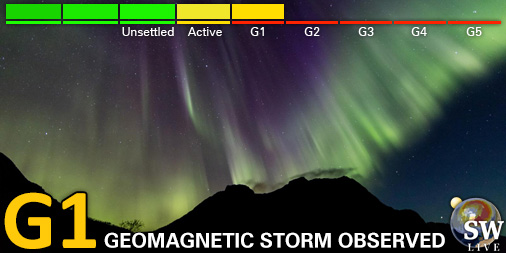Het archief bekijken van maandag 7 april 2003
Activiteitenrapport
Bij elke genoemde zonnevlam in dit rapport werd een schaalfactor toegepast door het Space Weather Prediction Center (SWPC). Vanwege de SWPC-schaalfactor worden zonnevlammen 42% kleiner gerapporteerd dan voor de wetenschappelijke data. De schaalfactor werd verwijderd uit onze gearchiveerde zonnevlamdata om de werkelijke fysieke eenheden weer te geven.
Rapport van de zonne- en geofysische activiteit van 2003 Apr 07 2200 UTCOpgemaakt door de NOAA © SWPC en verwerkt door Poollicht.be
USAF/NOAA rapport van de zonneactiviteit en geofysische activiteit
SDF Nummer 097 gepubliceerd omstreeks 2200Z op 07 Apr 2003IA. Analyse van de actieve zonneregio's en zonneactiviteit van 06-2100Z tot 07-2100Z
Solar activity was at low levels. Region 324 (S13W85)
produced a C2 flare at 07/0304Z. Region 324 was to be the source of
the majority of activity during the past twenty-four hours. Region
324 continues to simplify and decay as it transits the west limb.
Region 325 (N15W63) and Region 331 (S07W34) are the two largest
regions on the disk but are relatively unchanged since yesterday.
New Region 332 (N11E58) was numbered today.
IB. Voorspelling zonneactiviteit
Solar activity is expected to be at
low levels. Regions 324, 325, and 330 (N07E38) continue to
represent C-class potential with a slight chance of a minor M-class
event.
IIA. Samenvatting geofysische activiteit 06-2100Z tot 07-2100Z
The geomagnetic field was at quiet to unsettled levels. Greater than
2 MeV electrons at geo-synchronous orbit reached high levels today.
IIB. Voorspelling geofysische activiteit
The geomagnetic field is
expected to be quiet to unsettled with a chance of isolated active
conditions. A weak CME shock from the M1 event on 04 April is
expected to arrive late today or early on day one. A returning
coronal hole high speed stream is expected to produce unsettled to
isolated minor storm levels on day three.
III. Kans zonnevlammen van 08 Apr tot 10 Apr
| Klasse M | 20% | 20% | 15% |
| Klasse X | 05% | 01% | 01% |
| Proton | 01% | 01% | 01% |
| PCAF | green | ||
IV. Penticton 10.7 cm Flux
Geobserveerd 07 Apr 116 Voorspeld 08 Apr-10 Apr 110/105/100 90 dagen gemiddelde 07 Apr 134
V. Geomagnetische A index
Geobserveerd Afr/Ap 06 Apr 006/009 Geraamd Afr/Ap 07 Apr 007/008 Voorspeld Afr/Ap 08 Apr-10 Apr 015/015-012/015-020/020
VI. Kansen op geomagnetische activiteit van 08 Apr tot 10 Apr
| A. Gemiddelde breedtegraad | |||
|---|---|---|---|
| Actief | 30% | 20% | 30% |
| Kleine storm | 10% | 05% | 10% |
| Zware-ernstige stormcondities | 01% | 01% | 01% |
| B. Hoge breedtegraad | |||
|---|---|---|---|
| Actief | 30% | 25% | 40% |
| Kleine storm | 15% | 10% | 15% |
| Zware-ernstige stormcondities | 05% | 03% | 07% |
Alle tijden in UTC
<< Keer terug naar de dagelijkse overview pagina
Op basis van de huidige parameters is er nu geen kans op poollicht in België en Nederland
Laatste nieuws
Laatste forumberichten
Suggesties? 8Noorderlicht kans 6-1-2025 2Poollicht 1 januari 2025 2Naar Noorwegen in Maart? 3Noorderlicht kans 10/11-10-2024 56
Meer forumberichtenSteun Poollicht.be!
Om ook bereikbaar te blijven bij grote poollichtkansen hebben we een zware server nodig die alle bezoekers aankan. Doneer en steun dit project zodat we online blijven en je geen enkele poollichtkans mist!

Ruimteweer feitjes
| Laatste X-klasse uitbarsting | 28/03/2025 | X1.1 |
| Laatste M-klasse uitbarsting | 30/04/2025 | M2.03 |
| Laatste geomagnetische storm | 03/05/2025 | Kp5 (G1) |
| Zonnevlekkenloze dagen | |
|---|---|
| Laatste zonnevlekkenloze dag | 08/06/2022 |
| Maandelijks gemiddeld zonnevlekkengetal | |
|---|---|
| april 2025 | 140.6 +6.4 |
| mei 2025 | 77.3 -63.3 |
| Afgelopen 30 dagen | 107.9 -25.9 |



